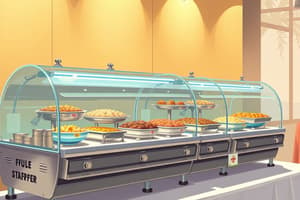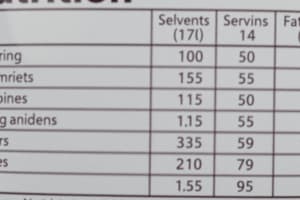Podcast
Questions and Answers
What are food serving machines designed to achieve in food service establishments?
What are food serving machines designed to achieve in food service establishments?
They are designed to dispense controlled portions of food to aid in portion management.
How do food serving machines contribute to hygiene in food service?
How do food serving machines contribute to hygiene in food service?
They minimize hand contact with food, promoting food safety and sanitation.
Name two benefits of using food serving machines related to cost.
Name two benefits of using food serving machines related to cost.
They help decrease food waste and over-portioning, leading to cost savings.
What feature of food serving machines allows for adherence to dietary requirements?
What feature of food serving machines allows for adherence to dietary requirements?
Why is staff training important when implementing food serving machines?
Why is staff training important when implementing food serving machines?
What type of food serving machine would a cafeteria use for bulk items?
What type of food serving machine would a cafeteria use for bulk items?
In what way do portion control scales enhance food serving?
In what way do portion control scales enhance food serving?
What initial consideration must be factored in before buying food serving machines?
What initial consideration must be factored in before buying food serving machines?
Flashcards are hidden until you start studying
Study Notes
Overview of Food Serving Machines for Portion Control
- Definition: Food serving machines are automated devices designed to dispense controlled portions of food, aiding in portion management.
Key Features
-
Accuracy:
- Ensures precise portion sizes to minimize waste.
- Reduces human error in serving sizes.
-
Consistency:
- Delivers uniform servings each time, maintaining quality across meals.
-
Customization:
- Allows setting specific portion sizes based on dietary requirements or preferences.
-
Efficiency:
- Speeds up the serving process in high-volume environments like cafeterias and restaurants.
-
Hygiene:
- Minimizes hand contact with food, promoting food safety and sanitation.
Benefits
-
Cost Reduction:
- Decreases food waste and over-portioning, leading to savings.
-
Dietary Compliance:
- Supports diet management by adhering to specific nutritional guidelines.
-
Enhanced Customer Satisfaction:
- Ensures patrons receive consistent meal quantities, improving service quality.
Types of Food Serving Machines
-
Dispensers:
- Used for bulk items like grains, cereals, and snacks.
-
Portion Control Scales:
- Measures food weight to ensure accurate servings.
-
Automated Serving Systems:
- Integrates with kitchen management software for tracking and inventory.
-
Plating Machines:
- Automatically plates meals in controlled portions for presentation.
Considerations for Implementation
-
Training:
- Staff must be trained to operate machines effectively.
-
Maintenance:
- Regular upkeep is essential for optimal performance and hygiene.
-
Cost:
- Initial investment can be high; benefits should be weighed against long-term savings.
Conclusion
Food serving machines play a crucial role in portion control, enhancing efficiency, consistency, and compliance with dietary standards in food service operations. Their implementation can lead to significant benefits in cost management and customer satisfaction.
Overview of Food Serving Machines for Portion Control
- Automated devices designed for dispensing controlled food portions, facilitating effective portion management.
Key Features
- Accuracy:
- Provides precise portion sizes to reduce waste and minimize human error during serving.
- Consistency:
- Ensures uniform servings each time, maintaining high-quality meal presentation.
- Customization:
- Allows for specific portion sizes tailored to dietary needs and personal preferences.
- Efficiency:
- Accelerates the serving process in busy settings like cafeterias and restaurants.
- Hygiene:
- Reduces direct hand contact with food, enhancing food safety and sanitation practices.
Benefits
- Cost Reduction:
- Lower food waste and over-portioning lead to substantial savings in food service operations.
- Dietary Compliance:
- Aids in diet management by adhering to defined nutritional guidelines.
- Enhanced Customer Satisfaction:
- Provides consistent meal quantities, thereby improving overall service quality.
Types of Food Serving Machines
- Dispensers:
- Designed for dispensing bulk items such as grains, cereals, and snacks.
- Portion Control Scales:
- Measures food weight accurately for ensuring proper servings.
- Automated Serving Systems:
- Connects with kitchen management software for efficient tracking and inventory control.
- Plating Machines:
- Automatically plates meals in controlled portions to enhance visual presentation.
Considerations for Implementation
- Training:
- Essential for staff to effectively operate food serving machines and maximize their benefits.
- Maintenance:
- Regular upkeep is crucial for ensuring optimal performance and maintaining hygiene standards.
- Cost:
- Initial investment may be substantial; stakeholders should consider long-term savings versus upfront costs.
Conclusion
- Food serving machines significantly improve portion control, efficiency, and dietary compliance in food service environments, resulting in better cost management and heightened customer satisfaction.
Studying That Suits You
Use AI to generate personalized quizzes and flashcards to suit your learning preferences.




